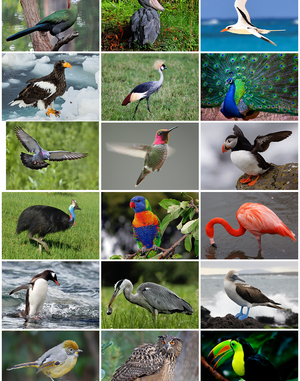
General features:
- Birds are cosmopolitan and found in all continents, seas and most islands.
- Their wide occurrence is due to their power of flight, which enables them to reach places unreachable to other animals.
- Most of them can fly and a few have lost the power of flight.
- The birds evolved in the Jurassic period from bipedal dinosaur reptiles.
- They are often described as ‘glorified reptiles’ because of their resemblances with and origin from the reptiles and magnificent look.
- Body temperature:
- They are homeothermic (warm blooded) and the body temperature is over 1000F which provides high metabolic rate for quick energy supply.
- Birds are endothermic, and expend a lot of energy to keep warm.
- Body form and appendages:
- The body is boat shaped and streamlined.
- It is divisible into head, neck, trunk and tail.
- The forelimbs are modified into wings for flight which are worked by powerful breast muscles attached to the sternum.
- Each fore limb has 1 to 3 digits and each hind limb has 1 to 4 digits.
- The hind limbs are used for perching, walking, hopping, wading, swimming etc.
- Skin is dry and thin except for uropygial or oil gland on the tail.
- Body is covered by epidermal horny skeleton of feathers which conserve body heat, help in flight and provide coloration to the birds.
- Endoskeleton:
- The endoskeleton is bony, but delicate and light.
- Skull is monocondylic, i.e with single occipital condyle.
- Sternum is usually large and with a median keel for thee attachment of flight muscles.
- Bones are pneumatic, i.e. contain air cavities to reduce weight.
- Digestive system:
- The mouth has a wide gap and jaws are covered with horny sheaths to form strong beaks.
- Beaks are adapted to various modes of feeding: seed-crushing, fruit-scooping, fish-tearing, nectar-sipping, wood-chiseling, grain-pickling etc.
- There are no teeth and food is swallowed unmasticated.
- The crop stores and softens food. Alimentary canal often has additional chambers; crop and gizzard.
- The gizzard is muscular to crush and churn the softened food.
- Some birds keep stone in the gizzard to effectively crush seeds and grains. Alimentary canal leads to the cloaca.
- Respiratory system:
- Respiration takes place only by lungs. The lungs are spongy and inelastic.
- A system of thin-walled air sacs lying among the viscera is associated with the lungs.
- This system maintains a constant draught of fresh air through the lungs, even during expiration.
- Voice box lies at the division of the trachea into bronchi called syrinx. The larynx doesn’t act as a sound box.
- Circulatory system:
- The heart is large and fast beating for quick supply of adequate amount of blood during flight.
- It is 4 chambered, having two auricles and two ventricles.
- Renal portal system is greatly reduced.
- RBCs are oval, biconvex and nucleated.
- Nervous system and sense organs.
- The brain is large with well-developed optic lobes and cerebellum and reduced olfactory lobes.
- There are 12 pairs of cranial nerves.
- The olfactory sacs open by internal nares into the buccal cavity.
- Most birds seem to lack the sense of smell and sharp eyesight help to see prey and other foods, land marks and resting places while flying high.
- Ear has an external opening, and a large, curved cochlea with organ of corti.
- Excretory system:
- Kidneys are metanephric and 3-lobed. The ureters open into the cloaca as there is no urinary bladder.
- They normally excrete uric acid (uricotelic) and urine is semisolid.
- Reproduction:
- There may be sexual dimorphism and the testes are paired.
- The ovary and the oviduct of the right side are absent in females.
- Gonoducts lead into cloaca and the fertilization is internal.
- They are oviparous. Eggs are large with much yolk and hard calcareous shell which need incubation, at a constant body temperature by parents.
- Males generally lack copulatory organs. Copulation occurs by cloacal apposition.
- Development is direct and embryonic membranes (amnion, chorion, allantoin and yolk sac) are formed.